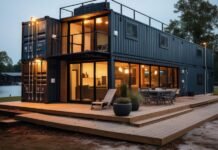The Rise of the Global Foldable Container House Market: An Innovative Solution for Modern Living
The housing market continues to evolve as innovative solutions emerge to address the pressing needs of a growing global population. One such solution that is rapidly gaining traction is the foldable container house. According to recent analysis, the global foldable container house market is projected to grow from USD 8.34 billion in 2023 to USD 22.53 billion by 2033, achieving a robust compound annual growth rate (CAGR) of 10.45% during this period. This article delves into the factors driving this growth, the benefits of foldable container homes, and the challenges that still need to be addressed.
Understanding Foldable Container Homes
Foldable container homes are an innovative housing solution made from repurposed shipping containers designed to be easily transported and assembled. With their ability to be shipped and constructed on-site, these homes provide a flexible, eco-friendly alternative to traditional housing. They serve a variety of purposes, including residential homes, offices, and temporary shelters for disaster victims or construction workers.
The convenience of portability and quick assembly makes foldable container homes an attractive option in various settings, from urban environments to remote locations. Their inherent resilience and adaptability contribute significantly to their appeal, which is further bolstered by the rising costs associated with traditional housing.
Market Dynamics Fueling Growth
1. Rising Demand for Affordable Housing:
As urban areas become densely populated, the need for budget-friendly housing options has never been more critical. Foldable container homes provide a way to offer affordable housing solutions, striking a balance between cost, utility, and environmental sustainability.
2. Environmental Sustainability:
With increasing awareness of ecological issues, many consumers and builders are seeking sustainable living options. Container homes can be designed with energy-efficient features and are typically constructed with recycled materials, aligning with eco-conscious living trends.
3. Versatility and Adaptability:
From residential use to government applications, including emergency shelters and military facilities, foldable container homes can be customized for various purposes. This versatility is crucial for families and businesses that desire flexible living and working spaces.
Target Market Segments
Based on a recent report, the foldable container house market is divided into several key segments, each displaying unique growth patterns:
1. By Type:
The market comprises fixed and movable containers, with the latter anticipated to capture the largest share. Movable homes are designed for easy relocation, catering to individuals who may frequently change residences due to work or lifestyle changes.
2. By Architecture Type:
Among architecture types, tiny houses are expected to grow the fastest. The compact nature of these homes appeals to a growing demographic seeking minimalist living solutions, as they can be moved and set up with relative ease.
3. By End-User:
The individual and family segment is projected to experience significant growth, driven by the increasing need for flexibility in housing options. Many individuals are drawn to the freedom of moving their homes to suit changing personal and professional circumstances.
Regional Insights
North America is expected to maintain the largest share of the foldable container house market, primarily due to advancements in design technology, including the implementation of artificial intelligence (AI) in production processes. AI is used to streamline the design phase, ensuring greater structural integrity and efficiency in the manufacturing of container homes.
In contrast, the Asia-Pacific market is anticipated to grow at the fastest rate. Rapid urbanization in countries like China, Thailand, and Australia has led to a heightened demand for affordable housing solutions, making foldable container homes particularly relevant.
Overcoming Challenges
Despite the clear benefits and growing interest in foldable container homes, hurdles remain. These homes often face regulatory obstacles regarding building codes and zoning laws. Sufficient infrastructure is necessary to support their widespread adoption, yet many regions lack comprehensive policies governing these types of residences. Additionally, customers may find a lack of customization options in current offerings, which can deter potential buyers looking for unique living solutions.
Competitive Landscape
The competitive landscape of the global foldable container house market features several noteworthy players, each striving to carve out their niche. Companies like HONOMOBO, Expandable Container Homes, and SG Blocks, among others, are leading the charge. These firms focus on product development and innovative design to maintain a competitive edge in the evolving market.
Conclusion
The foldable container house market exemplifies an innovative approach to modern living that combines affordability, sustainability, and versatility. As demand for housing solutions evolves, this market presents a compelling opportunity for investors and consumers alike. However, addressing regulatory challenges and enhancing customization options will be crucial for sustained growth. As stakeholders recognize the potential of foldable container homes, we can expect this sector to play a significant role in shaping the future of housing worldwide.














